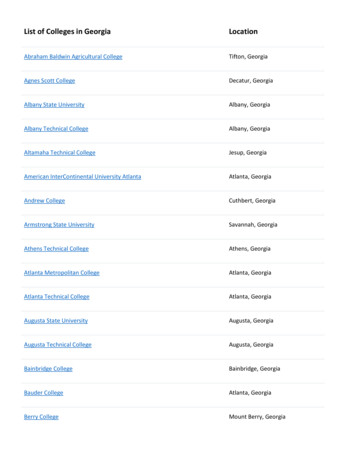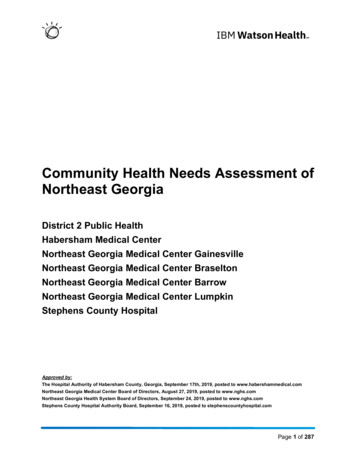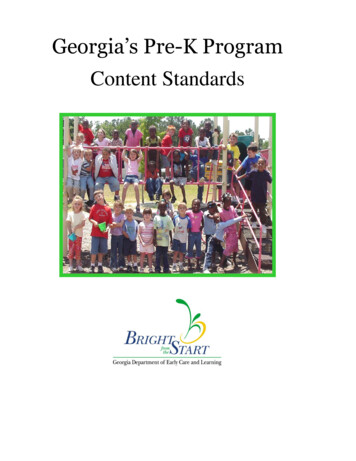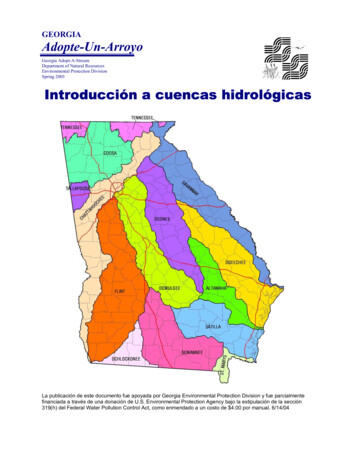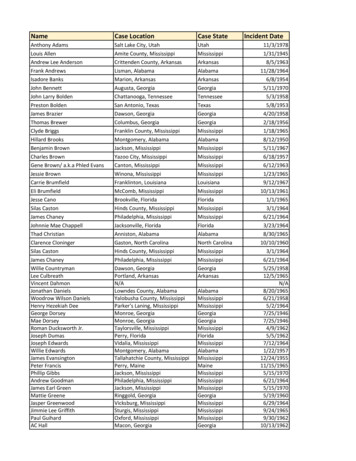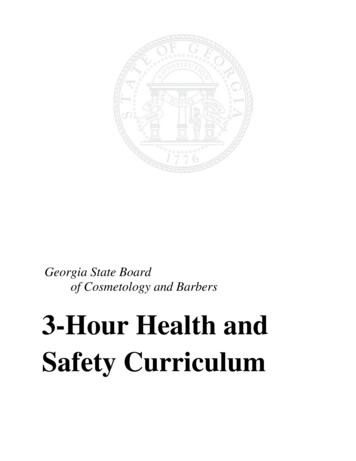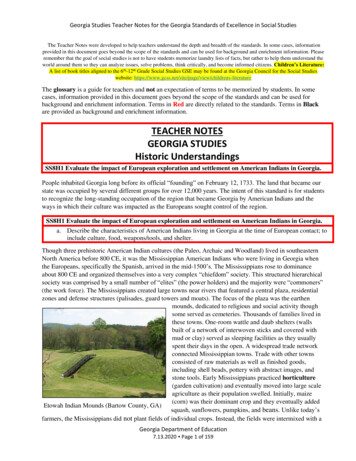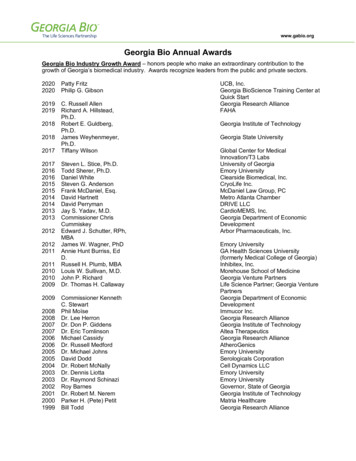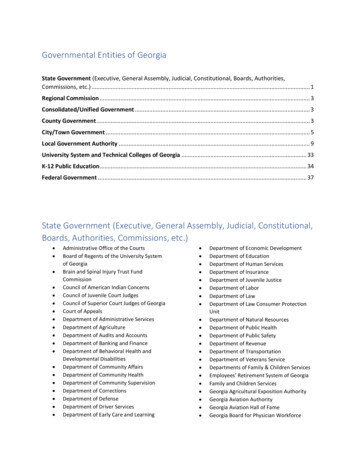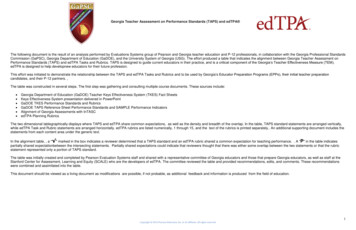
Transcription
Georgia Teacher Assessment on Performance Standards (TAPS) and edTPA The following document is the result of an analysis performed by Evaluations Systems group of Pearson and Georgia teacher education and P-12 professionals, in collaboration with the Georgia Professional StandardsCommission (GaPSC), Georgia Department of Education (GaDOE), and the University System of Georgia (USG). The effort produced a table that indicates the alignment between Georgia Teacher Assessment onPerformance Standards (TAPS) and edTPA Tasks and Rubrics. TAPS is designed to guide current educators in their practice, and is a critical component of the Georgia’s Teacher Effectiveness Measure (TEM).edTPA is designed to help developnew educators for their future profession.This effort was initiated to demonstrate the relationship between the TAPS and edTPA Tasks and Rubrics and to be used by Georgia’s Educator Preparation Programs (EPPs), their initial teacher preparationcandidates, and their P-12 partners. ,The table was constructed in several steps. The first step was gathering and consulting multiple course documents. These sources include: Georgia Department of Education (GaDOE) Teacher Keys Effectiveness System (TKES) Fact SheetsKeys Effectiveness System presentation delivered in PowerPointGaDOE TKES Performance Standards and RubricsGaDOE TAPS Reference Sheet Performance Standards and SAMPLE Performance IndicatorsAlignment of Georgia Assessments with InTASCedTPA Planning RubricsThe two dimensional tablegraphically displays where TAPS and edTPA share common expectations, as well as the density and breadth of the overlap. In the table, TAPS standard statements are arranged vertically,while edTPA Task and Rubric statements are arranged horizontally. edTPA rubrics are listed numerically, 1 through 15, and the text of the rubrics is printed separately. An additional supporting document includes thestatements from each content area under the generic text.In the alignment table, , a " " marked in the box indicates a reviewer determined that a TAPS standard and an edTPA rubric shared a common expectation for teaching performance. . A "P" in the table indicatespartially shared expectationbetween the intersecting statements. Partially shared expectations could indicate that reviewers thought that there was either some overlap between the two statements or that the rubricstatement represented only a portion of TAPS standard.The table was initially created and completed by Pearson Evaluation Systems staff and shared with a representative committee of Georgia educators and those that prepare Georgia educators, as well as staff at theStanford Center for Assessment, Learning and Equity (SCALE) who are the developers of edTPA. The committee reviewed the table and provided recommendations, edits, and comments. These recommendationswere combined and assimilated into the table.This document should be viewed as a living document as modifications are possible, if not probable, as additional feedback and information is produced from the field of education.1Copyright 2014 Pearson Education, Inc. or its affiliates. All rights reserved.
Georgia Teacher Assessment on Performance Standards (TAPS) and edTPA Some TAPS statements include expectations unrelated to any edTPA rubric. The table below lists those statements without a direct relationship.Standard 9: ProfessionalismStandard 10: Communication Show joy for the content material. Participate in collegial activities. Take pleasure in teaching. Demonstrate interest about students’ personal and developmental needs.Reduce isolation and develop a more consistent curriculum through collaborationwith peers from the same grade level and subject level. Adhere to legal and ethical guidelines, standards for the profession, and localschool board policies. Share knowledge and engage in collaborative problem-solving. Collaborate and network with colleagues to reach educational decisions. Demonstrate professional demeanor and positive interaction with others. Involve in acts of searching and inquiring to find a solution that will solveproblems encountered. Demonstrate involvement in learning activities inside and outside school. Assess and audit the gaps in professional practice. Incorporate learning from professional development activities into classroompractice. Find, implement, and share new instructional strategies. Network, share practices through dialogue, modeling, and demonstration withinand across schools. Share practices through mentoring, coaching, team teaching and shadowing. Support school change and initiatives.There are few important notes about what is not reflected on the table: edTPA Task 4 was not included because it only applies to Elementary Mathematics and Literacy.Cultural/Community Knowledge was not included as part of TAPS Standard 1The committee felt that TAPS Standard 8 statements concerning academic rigor and high expectations were more related than indicated on the table because rigor and high expectations are an underlyingtheme across all of edTPA.2Copyright 2014 Pearson Education, Inc. or its affiliates. All rights reserved.
Georgia Teacher Assessment on Performance Standards (TAPS) and edTPA Reading the table:A " " in a box indicates a shared expectation between the intersecting statements.A "P" indicates partially shared expectation between the intersecting statements.edTPA Rubric KeyTask 1: Planning for Instruction and AssessmentRubric 1: Planning for Content UnderstandingsRubric 2: Planning to Support Varied Student Learning NeedsRubric 3: Using Knowledge of Students to Inform Teaching and LearningRubric 4: Identifying and Supporting Language DemandsRubric 5: Planning Assessments to Monitor and Support LearningTask 2: Instructing and Engaging Students in LearningRubric 6: Learning EnvironmentRubric 7: Engaging Students in LearningRubric 8: Deepening Student LearningRubric 9: Subject-Specific PedagogyRubric 10: Analyzing Teaching EffectivenessTask 3: Assessing Student LearningRubric 11: Analysis of Student LearningRubric 12: Providing Feedback to Guide LearningRubric 13: Student Use of FeedbackRubric 14: Analyzing Students’ Language Use and Learning in ContentRubric 15: Using Assessment to Inform Instruction3Copyright 2014 Pearson Education, Inc. or its affiliates. All rights reserved.
Georgia Teacher Assessment on Performance Standards (TAPS) and edTPA edTPA Tasks and RubricsTask 1: Planning for Instruction and AssessmentLearner KnowledgePedagogicalKnowledgeCurricular KnowledgeSubject-matterKnowledgeStandard 1: Professional KnowledgeTask 2: Instructing and Engaging Students inLearningTask 3: Assessing Student 3456789101112131415 PPPHave accurate, cohesive, and in-depth subject-matter knowledge. PPossess a coherent body of knowledge about the facts, concepts,principles, methodology, and important generalization of the subjectareas taught. PMake interdisciplinary connections across subject areas to engagestudents in challenging, integrated, and exploratory learning. Know the school district curriculum guides and benchmarks.PUnderstand the scope and sequence of learning goals andobjectives.PDevelop appropriate curriculum guides and set up outlines for unitplans.PBe able to perceive the gap between planned curriculum andreceived curriculum.PPPP Choose the most effective pedagogical strategies that can bestcommunicate subject content. P P Design and organize learning activities that are appropriate forlearners of different interests and abilities to explore the topics,problems, or issues. P P Exhibit instructional practices that are supported by currentresearch.PP Have an understanding of special education and gifted education.P Relate subject-matter to the personal and social concerns thatappeal to the learners. P PKnow students as individuals regarding their learning abilities, priorachievement, cultural background, and personal interests. P PAnticipate the conceptions, misconceptions, and possibledifficulties the students are likely to have when learning particularcontent area. PPP PP4Copyright 2014 Pearson Education, Inc. or its affiliates. All rights reserved.
Georgia Teacher Assessment on Performance Standards (TAPS) and edTPA edTPA Tasks and RubricsTask 1: Planning for Instruction and AssessmentTask 2: Instructing and Engaging Students inLearningTask 3: Assessing Student LearningAlignment with CurriculumDifferentiated PlanningLearning ObjectivesStandard 2: Instructional 3456789101112131415Set clear, specific, and unambiguous learning objectives tocommunicate intended learning outcomes. Identify learning objectives that focus on high cognitive levels ofstudent learning (e.g., analysis, synthesis, evaluation, andcreation). Use learning objective to design instructional strategies andorganize learning activities. Encourage students to objectively evaluate their progress againstthe benchmark. Use student assessment and diagnostic data in instructionalplanning. Plan a learner-centered environment that allows for studentchoice, flexibility, and independence. PPP Use a variety of grouping arrangements and ensure high mobilitywithin the classroom.P Plan advanced learning (e.g., enrichment, curriculum compacting)for gifted learners. P Plan remediated learning for struggling students. P Construct a blueprint of how to address the curriculum during theinstructional time at the beginning of the school year or semester. Plan appropriate long-range learning and developmental goals forstudents. PP Align daily lesson plans with district curriculum guides. Sequencing learning materials and activities logically and developappropriate timelines for the completion of instructional units ofstudy. Identify and develop assessment strategies to determine theextent that intended learning has occurred. P5Copyright 2014 Pearson Education, Inc. or its affiliates. All rights reserved.
Georgia Teacher Assessment on Performance Standards (TAPS) and edTPA edTPA Tasks and RubricsTask 1: Planning for Instruction and AssessmentTask 2: Instructing and Engaging Students inLearningTask 3: Assessing Student LearningTeamPlanningResources andMaterialsStandard 2: Instructional 3456789101112131415Integrate other content areas when appropriate.PPPUse materials from a wide variety of resources for lessonplanning. PDetermine available technology resources and integratetechnology into instruction when it is value-added. PP Evaluate the quality of available resources when designing a unitor lesson. PPCollaborate with other teachers to make intra- and interdisciplinary connections.PP6Copyright 2014 Pearson Education, Inc. or its affiliates. All rights reserved.
Georgia Teacher Assessment on Performance Standards (TAPS) and edTPA edTPA Tasks and RubricsTask 1: Planning for Instruction and AssessmentInstructional strategiesStandard 3: Instructional StrategiesContent andExpectationsTask 3: Assessing Student 3456789101112131415Employ a variety of techniques and instructional strategies toenhance student motivation and decrease discipline problems. PUse both direct instruction and indirect instruction flexibly to serveappropriate learning purposes. Stress meaningful conceptualization, emphasizing the students’own knowledge of the world. Match instruction on students’ achievement levels and needs. Think through likely misconceptions that may occur duringinstruction and monitor students for these misconceptions. Connect the learning process and outcomes to the authenticcontexts in students’ real life. Adjust the delivery and pacing of the lesson in response to studentcues. Choose appropriate pedagogical strategies that can best presentthe content.CognitiveChallengeTask 2: Instructing and Engaging Students inLearningGive clear examples and offer guided practice.Make the learning student-centered. P P P P P Stress student responsibility and accountability in mastery ofcontent and skills. Teach students to reflect on learning progress. Is concerned with having students learn and demonstrate higherorder thinking skills rather than memorization of facts P Provide in-depth explanations of academic content and coverhigher- order concepts and skills thoroughly. P PStress meaningful concept mapping to connect new knowledgewith prior learning. 7Copyright 2014 Pearson Education, Inc. or its affiliates. All rights reserved.
Georgia Teacher Assessment on Performance Standards (TAPS) and edTPA edTPA Tasks and RubricsTask 1: Planning for Instruction and AssessmentStandard 3: Instructional StrategiesQuestioningTask 3: Assessing Student 3456789101112131415 PP P Use wait time during questioning. PP PRecognize the pattern in student learning and promptly adjustinstruction to maximize student learning. Ask questions that reflect type of content and goals of the lesson.Task 2: Instructing and Engaging Students inLearning Ask questions of varying depths of knowledge. 8Copyright 2014 Pearson Education, Inc. or its affiliates. All rights reserved.
Georgia Teacher Assessment on Performance Standards (TAPS) and edTPA edTPA Tasks and RubricsTask 1: Planning for Instruction and AssessmentDifferentiating ContentStandard 4: Differentiated 6789101112131415 Offer students choice regarding the complexity (depth) of contentthey want to start with so that they can experience academicsuccess. PPOffer multiple modes of learning for students to be exposed to thetarget content through their learning-style preferences (such asreading, listening, or doing). Vary types of assignment to assess student learning. Routinely combine instructional techniques that involve individual,small-group, and whole-class instruction. Monitor and pace instruction based on the individual needs ofstudents. Draw on a mental database of examples, metaphors, andenrichment ideas to provide personalized scaffold. Offer optimal amount of support/intervention and structure learningtasks to ensure the learning demand is appropriately challenging. Provide students with choices regarding the method to expressrequired learning, such as presentation, portfolios, or formal tests. Use rubrics that match and extend students’ varied ability levels. Increase the breadth of learning materials to enhance studentlearning motivation.Re-teach an idea or skill in small groups of struggling learners.Vary instructional strategies and activities for students.Differentiated ProcessTask 3: Assessing Student LearningRubricExtend and enrich the thinking or skills of advanced learners.DifferentiatingProductTask 2: Instructing and Engaging Students inLearningEncourage students to produce their own product assignment.Allow students to work alone or in small groups on projects. PPP P P(?)9Copyright 2014 Pearson Education, Inc. or its affiliates. All rights reserved.
Georgia Teacher Assessment on Performance Standards (TAPS) and edTPA edTPA Tasks and RubricsTask 1: Planning for Instruction and AssessmentLearningEnvironmentStandard 4: Differentiated InstructionTask 2: Instructing and Engaging Students inLearningTask 3: Assessing Student 3456789101112131415Create an environment in which student differences in ability,cultural background, academic needs and interest are respectedand treated as assets. Know and understand students as individuals in terms of ability,achievement, learning styles, and needs. 10Copyright 2014 Pearson Education, Inc. or its affiliates. All rights reserved.
Georgia Teacher Assessment on Performance Standards (TAPS) and edTPA edTPA Tasks and RubricsTask 1: Planning for Instruction and AssessmentStandard 5: Assessment StrategiesUse Different Formats of Teacher-Made AssessmentUse conventional multiple-choice, matching, alternate choice,true/false, and fill-in-the-blank questions appropriately.Use short answer, constructed response, and essay to encouragestudents to explain their understanding of important ideas andprinciples.Design performance tasks to ask students to show what they cando with the knowledge and skills learned.Observe students informally in the classroom to assess theirongoing learning.Encourage students’ self-assessment of their own thinking,reasoning, processes, and products.Clearly explain homework.Design diagnostic assessment to identify students’ strengths,weaknesses, and mental readiness for learning new content orskill.Use formative assessment to monitor student learning progressand modify instruction.Use summative assessment to determine the student attainment ofthe standards of subject areas.Be a critical consumer of available assessment resources.Task 2: Instructing and Engaging Students inLearningTask 3: Assessing Student 3456789101112131415 P11Copyright 2014 Pearson Education, Inc. or its affiliates. All rights reserved.
Georgia Teacher Assessment on Performance Standards (TAPS) and edTPA edTPA Tasks and RubricsTask 1: Planning for Instruction and AssessmentStandard 5: Assessment 789101112131415Match assessment to intended learning objectives.Align assessment with written and taught curriculum.Validity of AssessmentTask 3: Assessing Student LearningRubricRelate assessment to the content under study and to studentcapacity.Use assessment that can truly reveal whether students understandthe learning.Use ongoing assessment to monitor student progress.Use multiple assessments to determine whether a student hasmastered a skill.Design assessments to assess both higher- and lower-level contentand skills. Exercise accommodations in assessment for students with specialneeds.PUse robust rubrics or scoring guides for student assignments,products, and projects.Task 2: Instructing and Engaging Students inLearningP 12Copyright 2014 Pearson Education, Inc. or its affiliates. All rights reserved.
Georgia Teacher Assessment on Performance Standards (TAPS) and edTPA edTPA Tasks and RubricsTask 1: Planning for Instruction and AssessmentStandard 6: Assessment UsesTask 2: Instructing and Engaging Students inLearningTask 3: Assessing Student 3456789101112131415Use assessment data to check for understanding and adequacy oflearning. Identify and Enhance Student LearningReturn student work in a timely manner.PPAssess, comment on, and discuss homework in class.Give clear, timely, and informative oral or written feedback.PPPPPP Interpret data of teacher-made assessment and standardizedassessment accurately and make inferences about studentprogress and challenges.PP Provide students with opportunities to reflect on their performancethemselves and ask questions. Provide opportunities for students to reengage with the content andskills of the curriculum, rather than focusing solely on the grades.Use assessment data to set future achievement goals.PPShare progress reports with students and parents in a timelymanner.Provide differentiated instruction based on assessment analysis. Document student progress and achievement over time.Remediate the learning of students who did not achieve mastery. PP PP 13Copyright 2014 Pearson Education, Inc. or its affiliates. All rights reserved.
Georgia Teacher Assessment on Performance Standards (TAPS) and edTPA edTPA Tasks and RubricsTask 1: Planning for Instruction and AssessmentStandard 6: Assessment UsesTask 3: Assessing Student 3456789101112131415Use assessment data to self-assess instructional effectiveness andidentify areas of strengths and weaknesses.Improve InstructionTask 2: Instructing and Engaging Students inLearning Make instructional decisions based on student achievement dataanalysis.PPMake pedagogical decisions more responsive to student learningneeds. PDesign appropriate interventions for students in need of additionalor different forms of instruction. PUse information gained from ongoing assessment for remediationand instructional planning. P P PP 14Copyright 2014 Pearson Education, Inc. or its affiliates. All rights reserved.
Georgia Teacher Assessment on Performance Standards (TAPS) and edTPA edTPA Tasks and RubricsTask 1: Planning for Instruction and AssessmentCaringStandard 7: Positive Learning 6789101112131415PPEncourage student cohesiveness and cooperation. PPEmphasize functional communication between teacher andstudents and among fellow students. PShow concerns for students’ emotional and physical well-being.Create a warm and supportive classroom climate.Fairness andrespectPrevent situations in which a student loses peer respect.Treats students fairly.Create situations for all students to succeed.Show respect to all students.Maintain professional role while being friendly.Give students responsibility.Value what students say.Task 3: Assessing Student LearningRubricRespond to misbehavior on an individual level and privately.Interactions withstudentsTask 2: Instructing and Engaging Students inLearning PPPPPPPPPP 15Copyright 2014 Pearson Education, Inc. or its affiliates. All rights reserved.
Georgia Teacher Assessment on Performance Standards (TAPS) and edTPA edTPA Tasks and RubricsTask 1: Planning for Instruction and AssessmentClassroom ManagementStandard 7: Positive Learning 6789101112131415 Establish rules, routines, and procedures early on in the schoolyear. Orchestrate smooth transitions and continuity of classroommomentum. Is aware of all activities in the classroom.PAnticipate potential problems.P PPPPUse space, proximity, or movement around the classroom fornearness to trouble spots and to encourage attention.Prepare materials in advance and have them ready to use. PPUse effective questioning, smooth transitions, and challenging butinteresting activities to increase student engagement and minimizedisruption.Reinforce and reiterate expectations for positive behavior.Use both punishment and positive reinforcement to encouragedesirable student behavior.P PPPImplement rules of behavior fairly and consistently.P Organize classroom space efficiently to support learning activities.Interpret and respond to inappropriate behavior promptly.Task 3: Assessing Student LearningRubricUse consistent and proactive discipline.Manage the physical factors (e.g., spatial environment, visualenvironment) to optimize student learning.Discipline ofstudentsTask 2: Instructing and Engaging Students inLearningPP PPP P16Copyright 2014 Pearson Education, Inc. or its affiliates. All rights reserved.
Georgia Teacher Assessment on Performance Standards (TAPS) and edTPA edTPA Tasks and RubricsTask 1: Planning for Instruction and AssessmentStandard 8: Academically Challenging 6789101112131415PPPPP PPPPPP Maximize instructional time.Academic RigorLimit disruption and interruptions.Maintain momentum within and across lessons.Carefully link learning objectives and activities. Design challenging but achievable tasks that are relevant tostudents’ lives and experiences, or to current events.Develop objectives, questions, and activities that reflect higher- andlower- cognitive skills as appropriate for the content and thestudents.Ensure the interactions in classroom have a task orientation.Link learning to students’ real-life experiences.Organize content for effective presentation.PP Check student understanding and retain student attention by askingquestions.Consider student attention span and learning styles whendesigning lessons. Be supportive and persistent in keeping students on tasks andencourage them to actively integrate new information with priorlearning.Let students have some degree of control over the content ormethods of learning to encourage their ownership and autonomy oflearning.Task 3: Assessing Student LearningRubricFocus classroom time on teaching and learning.Student Motivationand EngagementTask 2: Instructing and Engaging Students inLearningP PPP P P17Copyright 2014 Pearson Education, Inc. or its affiliates. All rights reserved.
Georgia Teacher Assessment on Performance Standards (TAPS) and edTPA edTPA Tasks and RubricsTask 1: Planning for Instruction and AssessmentHigh ExpectationsStandard 8: Academically Challenging EnvironmentSet clearly articulated high expectations for strong academicperformance for all students, including the students who are ethnicminorities or from low-income families.Task 3: Assessing Student 3456789101112131415P P P Orient the classroom experience toward improvement and growth.Stress student responsibility and accountability.Monitor student learning closely, and make certain that alternativeteaching methods are in place.Task 2: Instructing and Engaging Students inLearning PPP 18Copyright 2014 Pearson Education, Inc. or its affiliates. All rights reserved.
Georgia Teacher Assessment on Performance Standards (TAPS) and edTPA edTPA Tasks and RubricsTask 1: Planning for Instruction and ards andEthics of theProfessionEnthusiasmStandard 9: ProfessionalismTask 2: Instructing and Engaging Students inLearningTask 3: Assessing Student 3456789101112131415Show joy for the content material.Take pleasure in teaching.Demonstrate interest about students’ personal and developmentalneeds.Adhere to legal and ethical guidelines, standards for theprofession, and local school board policies.Demonstrate professional demeanor and positive interaction withothers.Involve in acts of searching and inquiring to find a solution that willsolve problems encountered.Demonstrate involvement in learning activities inside and outsideschool.Assess and audit the gaps in professional practice.Contribution to thelearningcommunityIncorporate learning from professional development activities intoclassroom practice.Find, implement, and share new instructional strategies.Network, share practices through dialogue, modeling, anddemonstration within and across schools.Share practices through mentoring, coaching, team teaching andshadowing.Support school change and initiatives.19Copyright 2014 Pearson Education, Inc. or its affiliates. All rights reserved.
Georgia Teacher Assessment on Performance Standards (TAPS) and edTPA edTPA Tasks and RubricsTask 1: Planning for Instruction and AssessmentReflective PracticeStandard 9: ProfessionalismTask 2: Instructing and Engaging Students inLearningTask 3: Assessing Student 3456789101112131415Know areas of personal strengths and weaknesses. Compare instructional practice to the best practices supported byextant research. Engage in structured reflection and inquire into own practice. Be analytical and evaluative about professional knowledge.Set high expectations for personal classroom performance.Demonstrate high efficacy.20Copyright 2014 Pearson Education, Inc. or its affiliates. All rights reserved.
Georgia Teacher Assessment on Performance Standards (TAPS) and edTPA edTPA Tasks and RubricsTask 1: Planning for Instruction and AssessmentParental InvolvementCommunication SkillsStandard 10: CommunicationTask 2: Instructing and Engaging Students inLearningTask 3: Assessing Student 3456789101112131415PPExplain content with a high level of clarity in classroom. Explain rules, expectations, and concepts in a logical, sequential,and age-appropriate manner Use a wide repertoire of communication behaviors (such asimmediacy, humor) to sustain a positive and interactive learningenvironment. Encourage an open, warm, communicative climate in classroomthat invites students’ comments, questions, and responses. Exhibit active listening.PDisplay interest and concern about the students’ lives outsideschool.P P P P P P P PKeep a log of parent communication.PProvide a description of record-keeping system and how it is usedto inform parents, students, and administrators.PCreate a climate of accessibility for parents and students. Share instructional goals, expectations, and student progress withfamilies in a timely and constructive manner.PPUse a variety of strategies to encourage parent-teachercommunication and connections, such as home visits, frequentpositive calls home, parent-teacher-student conferences,exhibitions of student work, and par
The effort produced a table that indicates the alignment between Georgia Teacher Assessment on Performance Standards (TAPS) and edTPA Tasks and Rubrics. TAPS is designed to guide current educators in their practice, and is a critical component of the Georgia's Teacher Effectiveness Measure (TEM).
